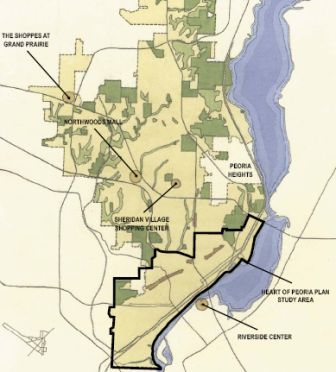UPDATE (4/11/07): Here’s an updated map of the Heart of Peoria Plan Area boundaries.
On tap Tuesday night at the City Council meeting: the long-awaited, much-anticipated Land Development Code (LDC).
What is it? The LDC is a big step toward codifying the Heart of Peoria Plan. It’s essentially new zoning laws for the Heart of Peoria Plan area (I’m using the term “zoning” in a generic sense here). In case you’re wondering what that area is, it’s the portion of Peoria within the heavy border on this illustration:

It covers roughly 8,000 acres of the oldest portion of Peoria. This part of town grew up in the 1800s and early 1900s when transportation was decidedly low-speed. Hence, there’s a lot of density in this part of town: houses are close together, businesses front the street, and things are generally built to pedestrian scale.
The problem is that the current zoning laws that cover this older portion of town are the same zoning laws that cover the suburban landscape of the northernmost portion of Peoria. Another way of saying this is that our zoning is “one size fits all.” But unfortunately, one size does not really fit all.
The zoning needs of north Peoria are a lot different than the zoning needs in the older parts of town. Whereas you would expect to find lots of surface parking in suburban areas and businesses set far back from the road (after all, the only access to these places is via automobile), you don’t expect this on Main street. On Main, you expect buildings to be built right up to the sidewalk, to utilize shared parking in back of the businesses or along the street, and to be pedestrian in scale.
But our “one-size-fits-all” zoning laws try to fit suburban design standards into older, urban parts of the city. Thus, we have developments like Campustown, and businesses like Jimmy Johns that set their business back 80 feet from the road with surface parking in front. This is not necessarily the fault of the developers, but rather the zoning laws that require suburban-style development without any regard for the urban character of the street. Like trying to put a round peg in a square hole, the result is, frankly, a mess.
And that’s where the Land Development Code comes in. The LDC is designed to preserve and maintain the urban character of the older parts of the city. It encourages redevelopment and infill, but with design standards that are compatible with the existing business districts and neighborhoods.
Form and use
In addition to the look, or form, of urban design, another big difference between urban and suburban zoning is in the area of permitted uses. In suburban areas, different uses are segregated: residential areas are separated from office parks, which are separated from retail areas, which are separated from industrial areas, etc. The only connections between each of these enclaves are streets, making suburbanites completely automobile-dependent.
In contrast, urban areas allow a mix of uses. Stores can have apartments above them, offices can be adjacent to or between retail shops, etc. This, coupled with the density and pedestrian scale of development, means that one’s basic needs are all within walking distance — one could conceivably live, work, and shop without having to drive (although driving is not precluded, of course).
What does that mean? It means less money spent on gasoline. It means that older people who are quite capable of living independently but can’t drive anymore don’t have to be “warehoused” in retirement homes. It means children who are old enough to go to the store unsupervised but not old enough to drive can ride their bikes to go shopping or to a movie instead of relying on someone to chauffeur them around.
But perhaps at its most basic level it means choice. Many people actually prefer to live in an urban area. In fact, the much ballyhooed “creative class” that Peoria is trying to attract likes urban living a lot, if surveys and polls are to be believed. Peoria has plenty of suburban amenities to offer, but is sorely lacking in urban living options. This is a chance to revitalize the older part of town, not by trying to mimic the suburbs which it could never do adequately anyway, but by building on its strengths.
Going forward
The Land Development Code is a big topic — too big to be discussed in just one blog post. So consider this an introduction. Today and tomorrow, I’ll be posting some follow-up posts about what the LDC has in it, what objections might come up, and of course, reaction to the city council discussion tomorrow night.
The code is such a big document, it’s unlikely that final action will be taken Tuesday night — although it could. I would expect, though, that this would span a couple of council meetings.
